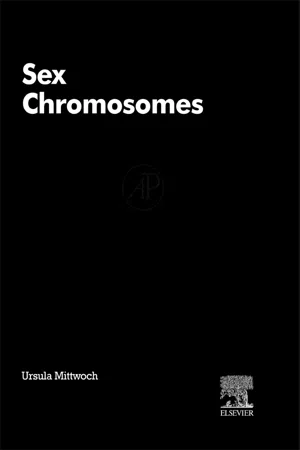
- 316 pages
- English
- ePUB (mobile friendly)
- Available on iOS & Android
Sex Chromosomes
About This Book
Sex Chromosomes focuses on the study of sex chromosomes, including human chromosomal abnormalities, behavior and characteristics of chromosomes, and cell division. The book first offers information on the chromosomal basis of sex determination, as well as development of the cell theory, mitosis, fertilization, meiosis, and discovery of sex chromosomes. The publication also ponders on the mitosis, meiosis, and formation of gametes. Discussions focus on the special characteristics of sex chromosomes, abnormalities of cell division, and sexual differentiation. The manuscript reviews sex chromosomes in plants, Drosophila, and Lepidoptera. The book also examines sex-chromosome mechanisms that differ the classic type; sex chromosomes in fishes, amphibia, reptiles, and birds; and sex chromosomes in man. Discussions focus on normal human sex chromosomes, Turner's syndrome, Klinefelter's syndrome, true hermaphrodites, testicular feminization, and pseudohermaphrodites. Sex chromosomes in mammals other than man, including monotremata, marsupialia, insectivora, rodentia, and carnivora, are discussed. The publication is a dependable reference for readers interested in the study of sex chromosomes.
Frequently asked questions
Information
THE CHROMOSOMAL BASIS OF SEX DETERMINATION
Publisher Summary
I Introduction
II The Development of the Cell Theory
III Mitosis
IV Fertilization
V Meiosis
VI The Beginning of Mendelian Genetics
Table of contents
- Cover image
- Title page
- Table of Contents
- Copyright
- PREFACE
- Chapter 1: THE CHROMOSOMAL BASIS OF SEX DETERMINATION
- Chapter 2: MITOSIS, MEIOSIS, AND THE FORMATION OF GAMETES
- Chapter 3: SEX CHROMOSOMES IN PLANTS
- Chapter 4: SEX CHROMOSOMES IN DROSOPHILA
- Chapter 5: SEX CHROMOSOMES IN LEPIDOPTERA
- Chapter 6: SEX-CHROMOSOME MECHANISMS WHICH DIFFER FROM THE CLASSIC TYPE
- Chapter 7: SEX CHROMOSOMES IN FISHES, AMPHIBIA, REPTILES, AND BIRDS
- Chapter 8: SEX CHROMOSOMES IN MAN
- Chapter 9: SEX CHROMOSOMES IN MAMMALS OTHER THAN MAN
- Chapter 10: SEX CHROMATIN
- Chapter 11: HETEROCHROMATIN
- Chapter 12: THE FUNCTION OF THE SEX CHROMOSOMES
- BIBLIOGRAPHY
- AUTHOR INDEX
- SUBJECT INDEX